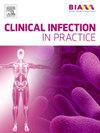盘尾丝虫病通过前节眼检查和FDG-PET/CT显像确诊
Q3 Medicine
引用次数: 0
摘要
眼盘尾丝虫病,俗称“河盲症”,是一种由盘尾丝虫病引起的寄生虫感染。虽然在英国的表现极为罕见,在文献中没有明显的报告,但它是世界范围内传染性失明的第二大原因。传统的诊断方法是通过皮肤切片活检、血清学检测和(如有)定量聚合酶链反应。由于在流行地区可用性有限,传统上不使用诊断成像。病例报告:在本病例中,一名患有复发性前葡萄膜炎的男性在伦敦三级眼科就诊,前段眼穿刺检查显示微丝虫病,氟脱氧葡萄糖-正电子发射断层扫描/计算机断层扫描显示盘尾丝蚴,这两项检查在超声引导下的细针穿刺中发挥了至关重要的作用,从而证实了诊断。结论本病例强调了前段检查和诊断影像在感染性疾病诊断中的作用。它也证明了在眼盘尾丝虫病中所见的体内微丝虫病的新的前段眼影像学表现。本文章由计算机程序翻译,如有差异,请以英文原文为准。
Onchocerciasis identified with anterior segment ocular examination and FDG-PET/CT imaging
Background
Ocular onchocerciasis, commonly known as “river blindness,” is a parasitic infection caused by the filarial nematode Onchocerca volvulus. Although presentation within the United Kingdom is extremely rare, with no reports evident within the literature, it is the second leading cause of infectious blindness worldwide. Diagnosis is traditionally made through skin snip biopsy, serological testing and, where available, quantitative-polymerase chain reaction. Diagnostic imaging is not traditionally utilised due to limited availability within endemic regions.
Case Report
In this case, of a man presenting to a tertiary London ophthalmology unit with recurrent anterior uveitis, both anterior segment ocular examination with paracentesis, demonstrating microfilariae, and fluorodeoxyglucose – positron emission tomography / computed tomography, demonstrating an onchocercoma, play a crucial role in allowing targeted ultrasound-guided fine needle aspiration which confirmed the diagnosis.
Conclusion
This case highlights the role of anterior segment examination and diagnostic imaging in the diagnosis of infectious diseases. It also demonstrates novel anterior segment ocular imaging findings of in vivo microfilariae as seen in ocular onchocerciasis.
求助全文
通过发布文献求助,成功后即可免费获取论文全文。
去求助
来源期刊

Clinical Infection in Practice
Medicine-Infectious Diseases
CiteScore
2.10
自引率
0.00%
发文量
95
审稿时长
82 days
 求助内容:
求助内容: 应助结果提醒方式:
应助结果提醒方式:


